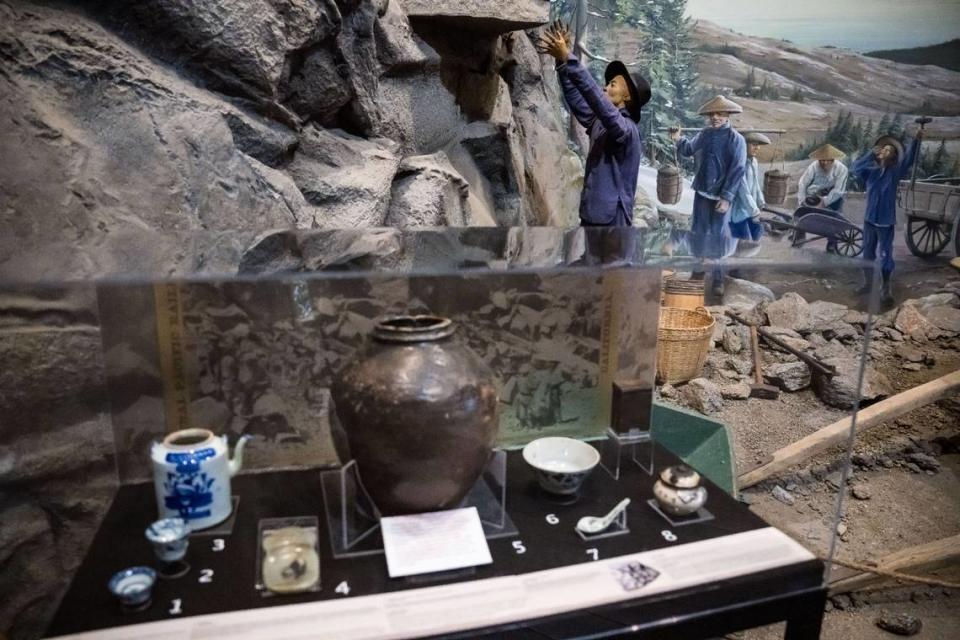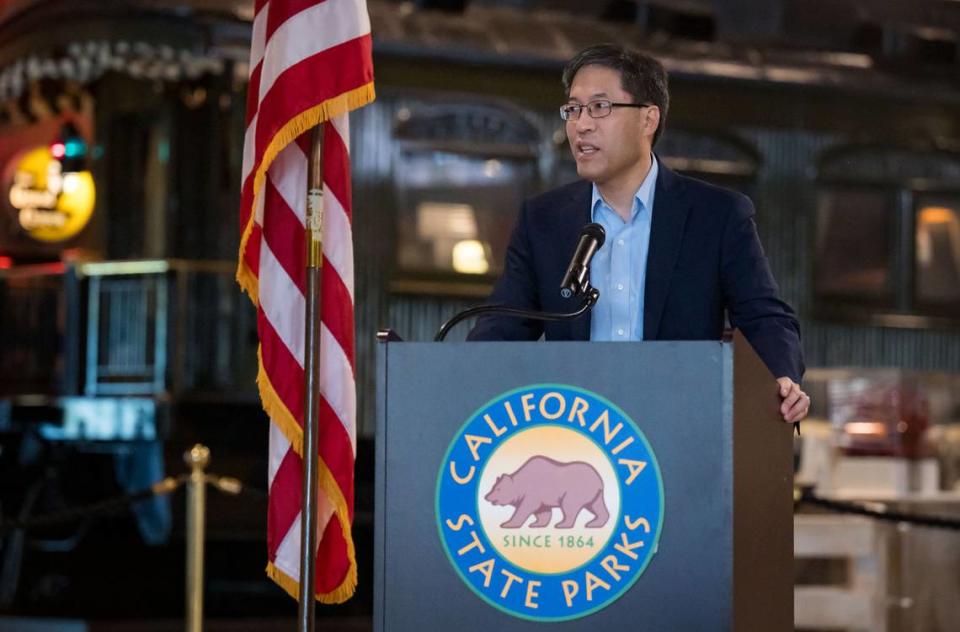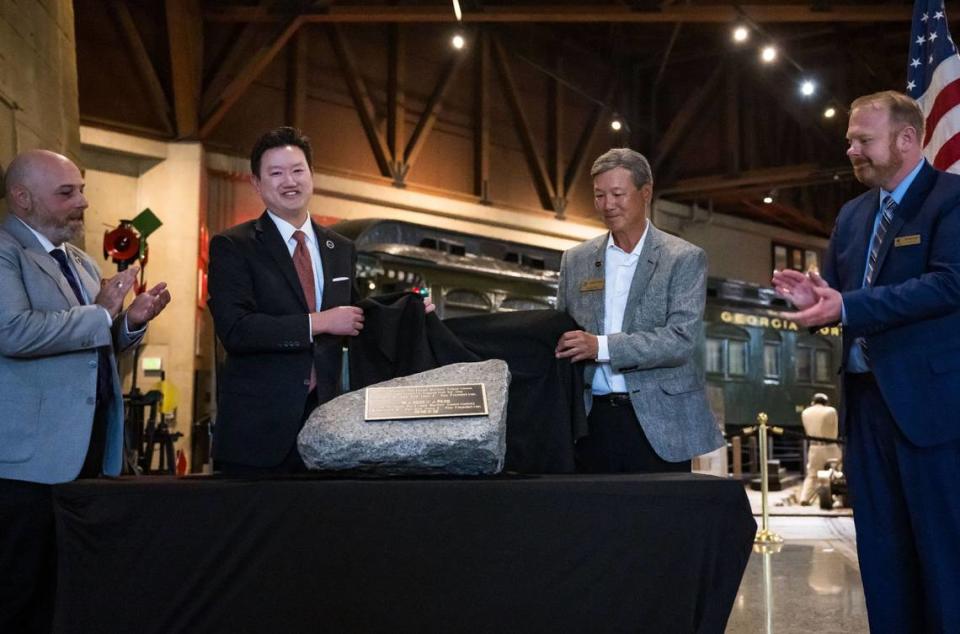California railroad museum ceremony highlights often-overlooked efforts of Chinese workers
- Oops!Something went wrong.Please try again later.
Chinese community and local leaders gathered at the California State Railroad Museum on Wednesday evening to dedicate a museum exhibit to the late board member and civic leader Dr. Herbert Yee.
Speakers included former state Sen. Richard Pan and representatives of Gov. Gavin Newsom and U.S. Rep. Doris Matsui, who highlighted the contribution of Chinese immigrants to the state and country — and warned about history repeating itself in the form of newly signed and proposed laws in Florida and Texas, respectively, that have been criticized as discriminatory toward Chinese citizens.
Museum director Ty Smith and CEO Tim Schroepfer presented members of Yee’s family with a commemorative plaque at the event to be placed by the “Sierra scene,” a diorama depicting Chinese workers building the Transcontinental Railroad through the Sierra Nevada mountains.
Chinese immigrant contributions ‘rendered invisible’
Chinese workers made up about 90% of the West Coast Transcontinental Railroad construction workforce, building tunnels through the Sierra Nevada mountains with rudimentary tools.

After the completion of the railroad, many Chinese workers continued working on infrastructure projects across the West Coast, including flood levees in Sacramento.
“From building the railroads, developing farmlands, forming civic infrastructure, and defending our nation, our forefathers have shaped and lived the American dream,” said David Yee, California Commissioner on Asian American and Pacific Islander affairs and Herbert Yee’s grandson. Herbert Yee died in 2021.
But Chinese contributions have often been “rendered invisible,” Pan said at the event. The famous photo of workers gathered at Promontory Point at the completion of the Transcontinental Railroad contains no Chinese workers within it, Pan pointed out, while Chinese workers’ participation in the project was driven by exclusionary laws in the first place.
The Foreign Miners’ Tax passed by California in 1850 prevented many Chinese workers from prospecting for gold or silver, while other laws prevented Chinese immigrants from obtaining citizenship or owning land in California.
History repeating: New laws bring concern of Chinese exclusion
Exhibits like the “Chinese Railroad Worker Experience” at the railroad museum, highlighting the discrimination and exclusion faced by Chinese Americans, are especially important in the face of new bills in Texas and Florida that would prevent Chinese nationals from owning land, Pan said.

“It’s so important to know that history can be repeated in the present. What was history is now news again,” he said.
The museum, and prior commemorations of the Transcontinental Railroad, have struggled before with the exclusion of Chinese and Chinese American histories.
At a 1969 Promontory Point celebration for the 100 year anniversary of the completion of the railroad, U.S. Secretary of Transportation John Volpes said, “Who else but Americans could drill 10 tunnels in mountains 30 feet deep in snow? Who else but Americans could chisel through miles of solid granite? Who else but Americans could have laid 10 miles of track in 12 hours?”
Volpes failed to acknowledge that the Chinese workers who did the tunneling and mountain work were discriminated against and denied U.S. citizenship until at least 74 years later, Herbert Yee’s son and museum board member Wesley Yee said.
At the same celebration, Chinese American historian Phillip Choy was prevented from speaking even though he was listed on the program, Wesley Yee said.
Of more than 100 trained docents at the railroad museum today, Vicki Beaton, a former journalist and member of the US-China Railroad Friendship Association, said she is the only one of Chinese background.
“All these docents are white guys,” Beaton said. “Very few white women. Chinese, one … it’s kind of sad with the big population of Chinese (in the area).”
‘History lives within a community’: Chinese voices at forefront
But the museum has also made efforts to “move out of the way and provide a venue where people can tell their own stories,” said Smith, the museum director.
After opening in 1981, the museum added Herbert Yee to its board and hired Choy as a consultant when creating a diorama of Chinese railroad workers for the museum.
In 2019, on the 150th anniversary of the railroad’s completion, the museum debuted its “Chinese Railroad Worker Experience” exhibit, created with input and oral histories from members of a Chinese Community Advisory Committee convened by the museum.
“We don’t have the same range of historical information that we would have if we’re telling the story of the big names behind the building of the Transcontinental Railroad,” Smith said. “There are no records, and yet the history lives within a community. It lives within people…we also have screens (in the exhibit) that tell the stories of descendants and how that history is passed down from generation to generation.”
Herbert Yee’s story exemplifies the challenges and contributions of Chinese immigrants to the U.S. and local communities, his family said at the ceremony.

When Yee came to Sacramento in 1931 at the age of 6, Chinese exclusion laws were in full effect, Pan said Wednesday.
Despite his father having graduated from the University of Michigan in 1921 and living in the country, Yee was detained at Angel Island for a week. Until 1943, he had no pathway to U.S. citizenship. Before 1952, if he didn’t naturalize, he would not have been allowed to own real estate in California.
After immigrating, Yee “did not let grass grow under his feet,” his son Wesley Yee said at the ceremony. After attending Stanford University, Herbert Yee started a dental practice in the building his family previously lived in and that continues running today.
Yee served as the president of the state Board of Dental Examiners under then-Gov. Ronald Reagan; Yee was also president of the International College of Dentists and a regent of the University of the Pacific. He also invested in real estate and the development of shopping centers with tenants including Lucky supermarkets and the Sprouts Farmers Market in Land Park.
In 1969, Yee was appointed by then-Gov. Jerry Brown and then-President Reagan to serve on the Sacramento Gold Spike Centennial Committee. He hosted events for the centennial in the Confucius Temple in Sacramento’s Chinatown, and was tasked with bringing the golden spike – the ceremonial final spike that completed the Transcontinental Railroad – from the Stanford University museum to Sacramento.
He later served on the California State Railroad Museum’s board of directors for 30 years, before passing away in 2021.

